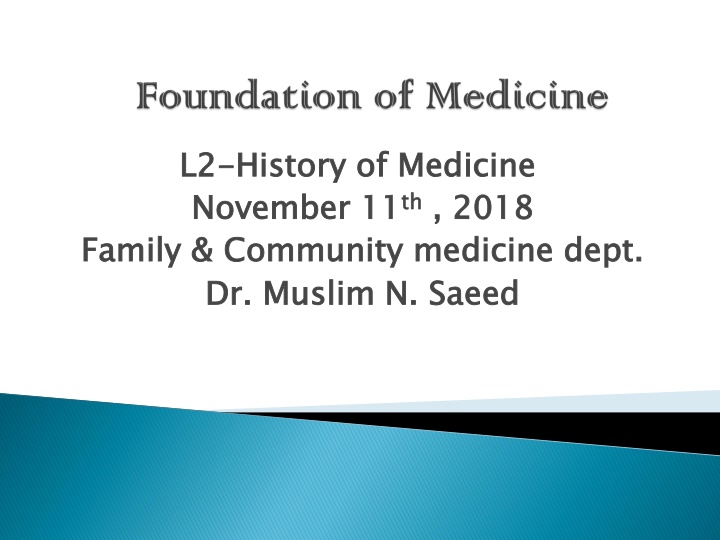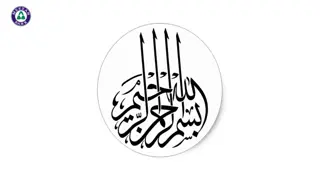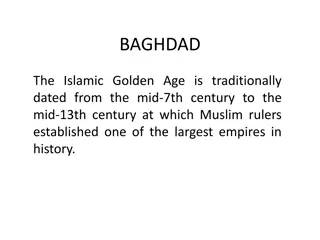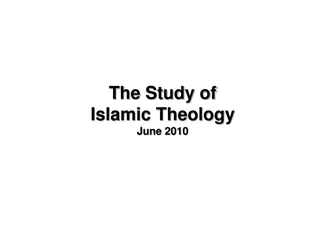
Islamic Contributions to Medicine: Hospitals and Physicians
The Islamic Empire made significant contributions to the field of medicine, establishing hospitals known as Bimaristans and nurturing physicians like Razi, Ibn-Sina, and Ibn Zuhr. Surgical procedures, clinical reports, and advancements in various medical fields marked the era of Islamic medicine, making it a pivotal period in medical history.
Download Presentation

Please find below an Image/Link to download the presentation.
The content on the website is provided AS IS for your information and personal use only. It may not be sold, licensed, or shared on other websites without obtaining consent from the author. If you encounter any issues during the download, it is possible that the publisher has removed the file from their server.
You are allowed to download the files provided on this website for personal or commercial use, subject to the condition that they are used lawfully. All files are the property of their respective owners.
The content on the website is provided AS IS for your information and personal use only. It may not be sold, licensed, or shared on other websites without obtaining consent from the author.
E N D
Presentation Transcript
L L2 2- -History of Medicine November Family & Dr. History of Medicine November 11 Family & Community medicine dept. Dr. Muslim N. 11th th, , 2018 2018 Community medicine dept. Muslim N. Saeed Saeed
Preservation of life is mandated by the following verse of the Quran: (The saving of one life is as if one has saved humanity). The importance of seeking treatment was emphasized by the Prophet himself in his sayings (Allah never created a disease for which he did not create a cure. So always seek treatment).
The Islamic Empire for more than 1000 years remained the most advanced and civilized nation in the world. Islamic medicine is one of the most famous and best-known facets of Islamic civilization.
The major contribution of the Islamic Age to the history of medicine was the establishment of hospitals. A large number of hospitals were developed early during the Islamic era. They were to be called Bimaristans. The first Islamic hospital was built during the reign of Caliph Harun Al-Rashid (170-193 AH 786-809 AD). One of these was the hospital, which was built under the instructions of the great Islamic Physician Al-Razi (Rhazes: 841-926 A.D.).
These hospitals varied in role, some aimed at serving the general population, with others providing specific services, such as the care of lepers, the disabled and the infirm.
Physicians such as Razi, Ibn-Sina (Avicenna: 980-1037 A.D.) and Ibn Zuhr (Avenzoar: 116 A.D.) studied patients and prepared them for student presentation. Clinical reports of cases were written and preserved for teaching.
Many surgical procedures amputation, excision of varicose veins and hemorrhoids, and orthopedics were widely taught. The use of plaster and casts after reduction of fractures was routinely shown to students. Ophthalmology was widely practiced. Surgical treatment of cataract was very common. Obstetrics was left to midwives. Many surgical procedures such as
During this period, students were assigned in small groups to famous physicians and experienced instructors, for ward rounds, discussions, lectures, and reviews. After examining the patients, students reported their findings to the instructors. After discussion, treatment was decided on and prescribed.
Licensing examination was carried out in Baghdad since 931A.D. From that time on, licensing examination was required to any one working in this job. Licensing boards were set up under a government official called Al-Muhtasib. The chief physician gave oral and practical examination, and if the young physician was successful, the Muhtasib issued a license.
Pharmacy, and chemistry had been studied by most Islamic Physicians. They also studied the techniques to refine drugs, medications and extracts by distillation, and crystallization. Drugs were classified into simple and compound drugs. The effects of drugs were detailed and documented in textbooks appeared frequently during the era of Islamic Medicine. Among these, is the contribution of Abu Bakr Bin Samghun of Cardoba on (The Comprehensive book on views of the Ancients as well as the Moderns on Simple Drugs).
The era of Islamic medicine produced some famous physicians. Many of them were skilled in medical writing and produced encyclopedic works, which became standard texts and reference works for centuries.
Jurjis Al-Rashid to come to Baghdad from Jundishapur . He became head a hospital in Baghdad till his death in 185 A.H., 801 A.D.). Jurjis Bukhtishu Bukhtishu: : was invited by Caliph Harun-
Masawaih He migrated from Jundishapur to Baghdad and became a celebrated ophthalmologist. He wrote the first Arabic treatise on Ophthalmology. His son Yuhanna Bin Masawayh wrote several medical works in Arabic while translating other works from Greek Masawaih: :
Hunayn He was the greatest translator of Greek texts He translated texts of Galen, Hippocrates, and Aristotle into Arabic. He was himself a physician and wrote two original works on ophthalmology. Hunayn Bin Is Bin Is- -Haq Haq:
Abu Ali Al 980-1037A.D.), Wrote 246 books, including Kitab-Al Shifa (The Book of Healing) and Al-Qanun fi Altib (The Canons of Medicine). The Qanun was the chief guide for medical science in the West from the twelfth to the seventeenth century. Ibn Sina s original contributions included: 1- Recognition of the contagious nature of tuberculosis. 2- distribution of diseases by water and soil. 3-nteraction between psychology and health. 4-Ibn Sina was also the first to describe meningitis and made rich contributions to anatomy, gynaecology and child health. Abu Ali Al- -Hussein Bin Hussein Bin Abdallah Abdallah Bin Bin Sina Sina: (Avicinna
Abu He wrote Kitab Al-Mansuri, and Al-Hawi, an encyclopedia of medicine in 20 volumes. Al-Razi was first placed in charge of the first Royal Hospital at Ray, from where he soon moved to a similar position in Baghdad where he remained the head of its famous Muqtadari Hospital for a long time. Abu Bakr Bakr Muhammad Bin Muhammad Bin Zakariya Zakariya Al Al- -Razi Razi:
Achievements of Ai-Razi: 1-He found a treatment for kidney and bladder stones 2-Explained the nature of various infectious diseases. 3-He also conducted research on smallpox and measles. 4-Was the first to introduce the use of alcohol for medical purposes. 5-Discribe the effect of psychological factors on health. 6-He was also an expert surgeon and the first to use opium for anesthesia.
Abul A.D.) was a famous surgeon in his time, -He wrote the medical encyclopedia Al-Tasrif Leman Ajaza Alta lif. -The Encyclopedia was being used as the standard textbook on surgery in universities in Europe. -He also performed many delicate operations such as Cesarean section and was also the first to use silk thread for stitching wounds. Abul Qasim Qasim Al Al- -Zahrawi Zahrawi: (Albucasis 963-1013
Ibn -was the first physician to discover the respiratory cardiovascular system, as proposed by Galen. -Ibn Al-Nafis stated that the blood could only travel from one side of the heart to the other by passing through the lungs. -Although he was unsure of the mechanism, Ibn Al Nafis correctly observed that the blood in the lungs mixing with air. Ibn Al Al- -Nafis Nafis: (born 1213)
-His other observation was that the heart was nourished by the web of capillaries surrounding it. -He touched upon the subject of the role of capillaries in circulation. -Ibn Al-Nafis was the first to understand the mechanisms behind the pulse. He believed that the pulsation was caused by the action of the heart pushing blood around the body.
-Some of his other observations were based upon his observations in dissection. -He corrected many misconceptions in physiology concerning the brain, gall bladder, bone structure and the nervous system. -His other great contribution to Islamic medicine was his pharmacological works, and the idea of dosages to administration of treatments.
Medical Ethics Very early in the history of Islamic civilization (second century after Hijra), Islamic medical ethical standards of practice were set, and the relationship between a physician and patient was defined. The physician was always held to the highest professional standards and ethics in treating his patient. One of the earliest treatises written on medical ethics was Adab Al-Tabib (Practical Ethics of the Physician) by Ishaq Bin Ali Al-Ruhawi, a ninth century physician practicing under the Islamic Caliphate. In this philosophical treatise, Ruhawi examined not only the relationships between a patient and a physician, but also a physician s personal standards of behavior, conduct of daily activities, morality and even his relationship with God. Medical Ethics
From the end of the period of Abbasid to the Ottoman era, the Arabic area experienced a period of deterioration of sciences and services. In the second half of the fourteenth century A.D., Marjan established a hospital in Baghdad called Dar Al-Shafa Hospital. After 500 years, Mohammad Pasha Bayraktar (died in 1844) built a hospital in Mosul during his tenure there. Madhat Pasha built a hospital in Baghdad/ Al- Karkh in the coast of Tigris in 1872 which contained 50 beds and was called Al-Ghuraba Hospital.
Namiq Pasha built (Namiq Pasha Hospital) in Bab Al- Mu adham, and the hospital was supplied by instruments and surgical equipment from Europe. In 1897, Rejab Pasha issued an order to use the existing building in Namiq Pasha Orchard as a military hospital and called it Majida Khista Khatoon hospital. This hospital was used as military hospital in 1917. Ottomans built Dar Al-Mualimin and Sabi Abkar hospitals in 1912, which were used for the treatment of wounded soldiers in the first world war.
The British established the department of health and the military doctor Colonel W R Batty was appointed as its chairman in 1918. However, the British then changed the department of health to the secretariat of health in 1919, which was managed by the military doctor Colonel D C Graham. Then the secretariat of health was changed in 1921 to the directorate of public health, which then turned to the ministry of health which managed by Iraqi doctor Hanna Khaiat. The ministry was abolished in 1922 and transformed to the directorate of public health, which was joined to the Ministry of Interior. In 1939, the ministry of social affairs was established, and the directorate of public health was joined with this ministry and its name was changed to (general inspectorate of social affairs and health).
On 1952, the ministry of health was established. During this period, many health establishments were founded. These include two hospitals in Rasafa and Karkh districts, establishment of health institutes. The military hospital was joined to the department of public health and its name was changed to Royal Hospital, college of medicine in Baghdad was founded in 1927. Health administration department was divided into 14 regions to administer health services in the Iraqi governorate, and the establishment of drugs and chemicals was founded to import the drugs, chemicals and equipments. In 1967, the higher health institutes were replaced by the institutes of health professions.
On 1970, public clinics were founded, and all health centers in all ministries were joined to the ministry of health. In 1975, the general directorate of health insurance and rural health services, and the general directorate of health education and training were joined to the ministry of health.
End End






















